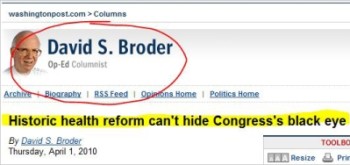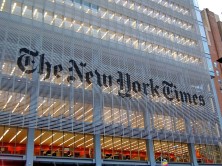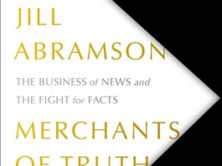
Detail from screen shot of Washington Post's David Broder's April 1st column
When I read David Broder’s recent column, dated April 1, I thought for sure it was an April Fool’s joke. He was lamenting the public’s low rating of Congress, arguing that the reason less than 20 percent of Americans approve our lawmakers’ job performance is “the spectacle the lawmakers have made of themselves these past 15 months.”
Really? Just the past 15 months, since the new Congress took office in 2009? What about Congress’ approximately 20 percent ratings during all of 2008? Or the generally low ratings that Congress has received over the past thirty-five years (since Gallup first began measuring Congressional approval in 1974)?
Truth be told, the American people don’t much like the “spectacle” of democracy-in-action. Two political scientists, John R. Hibbing and Elizabeth Theiss-Morse, examined public attitudes toward Congress fifteen years ago, reporting their findings in Congress as Public Enemy, a book that all pundits, pollsters, and politicians need to read if they really want to understand the public’s view of Congress.
According to the authors, Americans overwhelmingly support the institution of Congress, but they are perennially dissatisfied with its operation.
“People do not wish to see uncertainty, conflicting options, long debate, competing interests, confusion, bargaining, and compromised, imperfect solutions,” write the authors (p. 147). “They want government to do its job quietly and efficiently, sans conflict and sans fuss.”
Well, in any kind of true democracy, that isn’t going to happen. Democracy is all about exactly what the public doesn’t want to see – sausage-making with all its gory ingredients. All those ghastly aspects of the legislative process were in full bloom over the past year, with extensive media coverage of Congress as it addressed several important issues.
Indeed, Broder noted that Congress had accomplished a lot in the past 15 months. He then added, “Despite passage of a health-reform bill that will surely win a place in the history books along with economic stimulus and education aid measures that are large by any measurement, the prestige of the legislative branch has sunk to a historic low.” (emphasis added)
Broder’s error is in lamenting the low rating “despite passage” of these bills, when low public approval is almost certainly in large part because of all the messy activity that made their passage possible.
Actually, the “historic low” is also off the mark: Gallup measured a 14 percent approval in July 2008, as the banking crisis hit the news. In any case, the “historic” part misses the larger picture. For most of the past three and a half decades, approval has fluctuated in the 20 to 40 percent range – hardly a positive statement about the public’s long-term view of Congress.
Typically, Congressional approval is higher when Congress is not in session than when it is, not because Congress is doing nothing – as some cynics might contend – but because it’s not getting the negative publicity that inevitably accompanies the legislative process in action, when news reports are all about the messy conflict among lawmakers over bills being considered.
Congressional approval also fluctuates with the economic times. Gallup first measured majority approval of Congress in the wake of President Clinton’s 1998 state-of-the-union speech. This was in the midst of an economic boom, when he announced a balanced budget for the first time in decades. The approval ratings in January and February of that year (56 and 57 percent respectively) were the highest Congress had achieved to date.
With a booming economy, approval over the next two years fluctuated in the 40 to 50 percent level, dropping to 42 percent the week before the 9/11 terrorist attacks. Three days later, Congressional approval soared to 84 percent, as the public rallied around all three branches of government.
Eventually approval declined to its more historic levels, aided by the economic downturn. The summer of 2003 was the last time Gallup measure approval at 50 percent, and March 2005 was the last measure as high as 40 percent.
The current ratings for Congress, among the lowest if not a record low, are a consequence of two major factors – the continued economic downturn, and extensive news coverage of perhaps the most controversial piece of legislation (on healthcare) in the past half century.
During the past 15 months, there was much uncertainty, many conflicting options, very long (and rancorous) debates, a wide variety of competing interests, a whole lot of confusion, extensive bargaining, and (without doubt) a compromised, imperfect solution. All the things Americans don’t like to see. All the things that make a democracy what it is.
George Bishop is Professor of Political Science and Director of the Graduate Certificate Program in Public Opinion & Survey Research at the University of Cincinnati. His most recent book, The Illusion of Public Opinion: Fact and Artifact in American Public Opinion Polls (Rowman & Littlefield, 2005) was included in Choice Magazine’s list of outstanding academic titles for 2005 (January 2006 issue).
David W. Moore is a Senior Fellow with the Carsey Institute at the University of New Hampshire. He is a former Vice President of the Gallup Organization and was a senior editor with the Gallup Poll for thirteen years. He is author of The Opinion Makers: An Insider Exposes the Truth Behind the Polls (Beacon, 2008; trade paperback edition, 2009). Publishers’ Weekly refers to it as a “succinct and damning critique…Keen and witty throughout.”








